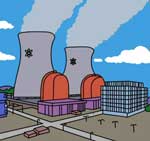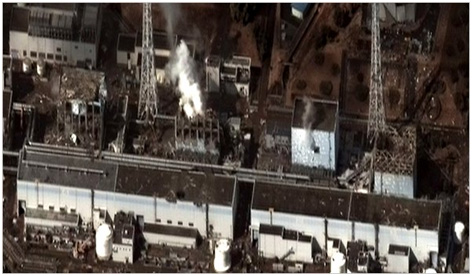Is TEPCO the New BP?
 Thursday, March 17, 2011 at 12:44AM
Thursday, March 17, 2011 at 12:44AM  Remember when the Deepwater Horizon drilling platform exploded and sank in the Gulf of Mexico, and BP immediately announced that one-thousand barrels of oil a day were spilling into the Gulf? The Coast Guard and news organizations dutifully repeated BP’s claim again and again for six straight days, but then something interesting happened: the lights came on and the underwater cameras started sending video from the ocean floor. Suddenly it became clear that BP was lying about how much oil they were dumping in the water. The actual spill-rate turned out to be 62,000 barrels per day, so you could say that BP understated the severity of the situation by a factor of sixty-two. Pretty dumb, even for an oil company.
Remember when the Deepwater Horizon drilling platform exploded and sank in the Gulf of Mexico, and BP immediately announced that one-thousand barrels of oil a day were spilling into the Gulf? The Coast Guard and news organizations dutifully repeated BP’s claim again and again for six straight days, but then something interesting happened: the lights came on and the underwater cameras started sending video from the ocean floor. Suddenly it became clear that BP was lying about how much oil they were dumping in the water. The actual spill-rate turned out to be 62,000 barrels per day, so you could say that BP understated the severity of the situation by a factor of sixty-two. Pretty dumb, even for an oil company.
Call me a conspiracy theorist, but I can’t help wondering whether Tokyo Electric Power Company (TEPCO) might be similarly understating what’s going on at the Fukushima Daiichi Nuclear Power Plant. Japan’s major news outlet has been claiming that things aren’t as bad as Three Mile Island, and the “experts” trotted out here in the U.S. have been assuring us that things won’t get as bad as Chernobyl. But on day six of the tragedy, right on schedule, the lights and cameras came on, and the world let out a collective gasp.
Unlike Chernobyl, which involved a single, 3,200-megawatt reactor, the current crisis involves six reactors totaling 4,700 megawatts. TEPCO was quick to point out that only three of the six were running at the time of the earthquake, but wasn’t nearly as quick with the factoid that the fuel rods they had removed from the out-of-service reactors were still sitting inside their respective reactor buildings. Thanks to the geniuses at General Electric who designed the reactors at Fukushima, these active fuel rods were stored in pools of water located above the reactor, alongside many years-worth of spent fuel rods. In this location, nuclear material is far more vulnerable than when it sits inside the highly reinforced core of the reactor itself, or gets put out to pasture in a dry cask. (The NRC disagrees on this last point.)
To make matters worse, fuel rods in the storage pools create an explosion hazard as soon as active cooling of the pool ceases, which happened after the plant got hit by a twenty-four foot tsunami. Fuel rods, whether active or spent, are highly radioactive and produce enough heat to boil off the water in the pool. Once enough water boils off and the rods become exposed to air, they react to create highly explosive hydrogen gas. Four of the six reactor buildings at Fukushima have now exploded, and three of those explosions have been attributed to loss of water in the fuel storage pools.
For days we have been told that workers at the plant are working to keep the fuel-rod pools filled with water. This effort, we are told, is ongoing alongside efforts to continue pumping cooling water into the reactors themselves. But today, Reuters published this satellite photo of the four buildings that endured explosions:
 Fukushima Dai-ichi Reactors 1-4, Reuters via DigitalGlobe
Fukushima Dai-ichi Reactors 1-4, Reuters via DigitalGlobe
The reactor buildings are the four, cube-shaped structures in the center, with reactor four inside what’s left of the building on the far left, and reactor two is inside the building that looks intact except for the little plume of steam coming out the hole. Reactors five and six are located elsewhere on the site.
Perhaps my years of experience working as an engineer inside industrial facilities makes this seem obvious, but look at buildings three and four (the ones on the left) and ask yourself honestly whether there’s an intact swimming pool in there keeping all those old fuel rods submerged. Hard to imagine?
As far as pumping cooling water into highly pressurized reactors, can you imagine that there are intact plumbing lines still connected to the reactors inside any of these buildings? The reinforced concrete walls that have been blown to hell were eighteen inches thick, and the explosions were so powerful they were felt twenty-five miles away. Any chance the plumbing in there is anything but a mangled mess of crumpled steel? Highly doubtful, with the exception of building two, but they’ve already admitted that that building has a breached reactor that doesn’t hold water anymore.
There’s now so much radiation leaking that it’s no longer safe to approach any of these buildings, so efforts have been reduced to shooting water cannons at the scrap heaps, hoping to hit something hot. And there’s plenty of hot stuff in there: Robert Alvarez from the Institute for Policy Studies reports that a single fuel-storage pool typically contains 20 to 50 million curies of Cesium-137 – perhaps the most dangerous isotope in this situation. We don’t know the total amount of Cesium-137 at risk at Fukushima, but with six storage pools and three reactors in play, it’s safe to assume it is many, many times the 6 million Curies that were inside the Chernobyl reactor when it exploded.
The workers who have stayed behind to try to avert total meltdowns are true heroes, just like the eleven who stayed on the drilling floor trying to bring a wild oil-well under control in the Gulf of Mexico. And like their brave counterparts from the oil industry, they will likely pay with their lives. A little honesty from TEPCO at this point would go a long way toward honoring their sacrifice.







Reader Comments